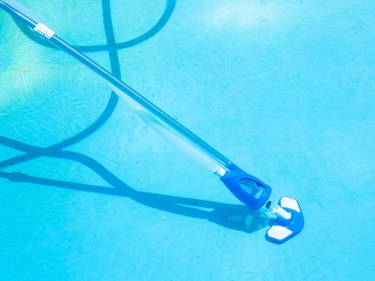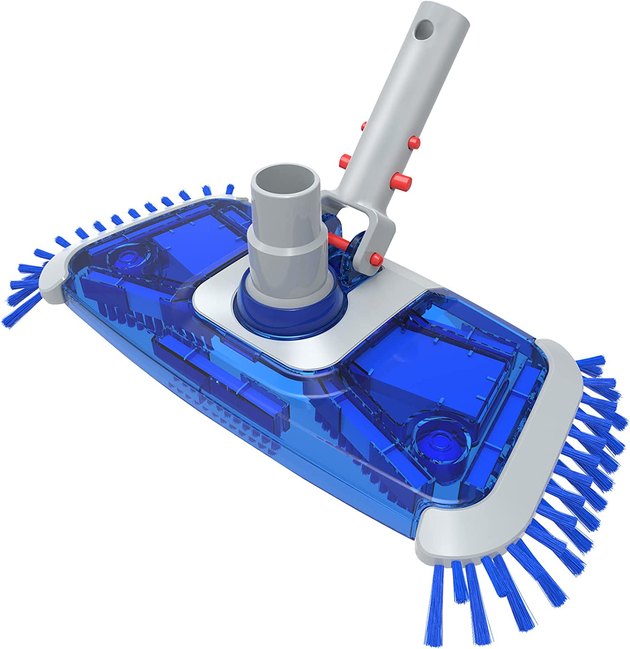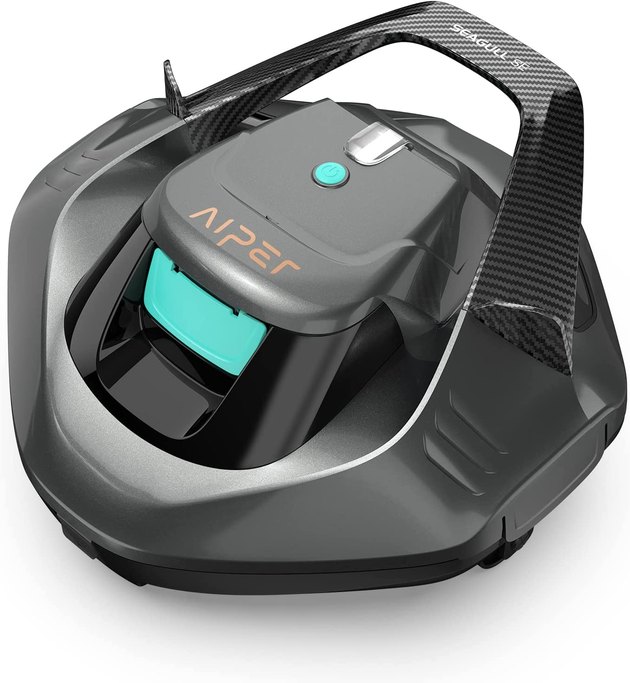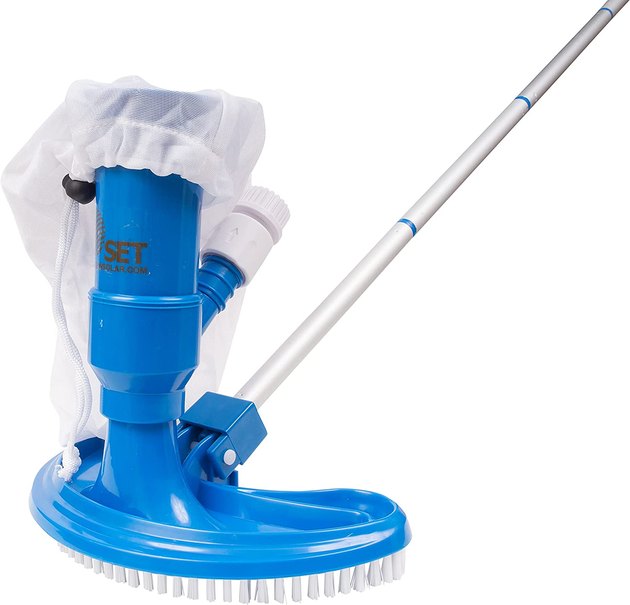
A swimming pool is basically a large dirt magnet, so it's important to vacuum your pool regularly. The pool's filter system usually takes care of debris suspended in the water, but once that debris settles onto the bottom of the pool, it stays there until you physically remove it. If you let dirt pile up on your kitchen or living room floor, the house looks messy, and the same is true for your swimming pool.
As a pool maintenance task, pool cleaning is just as important as balancing the chemicals, and it can help make that job a little easier. Organic debris that falls to the bottom, such as grass, twigs, and insects, acidifies the water as it decomposes and lowers the pool pH. It also reacts with chlorine, reducing the amount that's available for sanitization. Regularly vacuuming the pool to remove this debris helps keep the pH and chlorine levels where they need to be.
Video of the Day
Video of the Day
If you have plenty of time and appreciate a good workout, you can always clean your pool the old-fashioned way by manually brushing down the sides and floor of the pool with a pool brush and using a skimmer net to collect debris from the surface. This can be a practical cleaning option for a smallish above-ground pool, but it's a pretty time-consuming and inefficient way to clean a large in-ground pool. You're better off using a vacuum, and in addition to manual ones for DIY cleaning, there are three types of automatic pool vacuums that do the job for you.
Pool Vacuum Types
A pool vacuum has to do something with the waste it collects, and the traditional strategy is to connect it to the pool's filtration system with a long hose. The debris collected by the vacuum passes through the filter or, if the filter has a multiport fitting, the debris-filled water can simply be discarded as waste. Contemporary automatic pool vacuums collect the debris in a filter bag or basket. Some have to be connected to the pool pump to work, but some are self-contained units that can function without a pool vacuum hose.
Manual Pool Vacuums
A manual pool vacuum has a vacuum head that connects to a telescoping pole that lets you reach all parts of the pool. The a suction hose connects to the pool's pump system via the skimmer. The user simply pushes the head around the bottom of the pool and along the sides. The pump sucks water and debris through the filter and sends the filtered water back into the pool. Some systems also have a "waste" setting that bypasses the filter and simply disposes of the water outside of the pool; this is used when the water is especially dirty.
Because the pole is so long, it can be heavy and difficult to manipulate, making manual vacuuming somewhat tiring. Moreover, if you don't send the water to waste, you have to backwash or clean the filter after vacuuming; if you do send the water to waste, you have to add water to the pool. Some manual pool vacuums come with an attachment for a garden hose that powers the vacuum and refills the pool as you go.
Automatic Pool Vacuums
An automatic pool cleaner is like a Roomba for your pool. You can simply let it loose and let it do the cleaning while you do something else. There are three types:
- Suction side: A suction side vacuum uses the sucking power of the pool pump to remove debris. It connects to the pool skimmer, often using a vacuum plate over the skimmer to make an airtight connection. The suction generated by the pump clears debris and provides power for the vacuum, which is on wheels, to move around the pool. This is an economical type of vacuum, and it's easy to maintain, but it increases the load on the pump and can clog the pump strainer and the filter.
- Pressure side: A pressure side pool vacuum uses the positive pressure from the pool pump's return line to generate suction, and it sends debris into a filter bag attached to the vacuum head rather than back to the pump or out to waste. The pressure also propels the vacuum around the pool. This type of vacuum sometimes needs a booster pump to increase pressure, but it's better at collecting large debris, such as leaves and rocks, than a suction side vacuum.
- Robotic: A robotic pool cleaner is a corded or cordless self-contained unit that doesn't have to be connected to a pool vacuum hose. It collects all the debris in an internal basket that has to be manually emptied. It's the most energy-efficient type of pool vacuum because it doesn't put any extra load on the pool pump, even acting as a secondary filtration system. Many models are Bluetooth-compatible and programmable. They are more expensive to buy but save energy costs over the long run.
Things You'll Need
Skimmer vacuum plate (optional)
Elbow fitting (optional)
How to Use a Manual Pool Vacuum
Beginners who don't know how to vacuum a pool with a manual pool vacuum can benefit from a demonstration by a pool care pro, but it isn't necessary because the procedure is pretty simple. Before you start, turn on the pool pump. If you have a diatomaceous earth or sand filter, make sure the pressure isn't too high; if it is, stop and backwash the filter before continuing. If you have a cartridge filter, it's a good idea to clean it before vacuuming. If the pump has a multiport filter, choose whether to direct water through the filter or to waste, and set the filter valve accordingly.
1. Prepare the Vacuum
Connect the telescoping pole to the vacuum head, then attach the vacuum hose to the head. Make sure the hose is long enough to reach all parts of the pool. Immerse the vac head in the pool. Hold the other end of the vacuum hose against the return jet in the pool to fill the hose with water. Wait until bubbles stop coming from the vac head.
2. Connect the Hose to the Skimmer
If you have a skimmer vacuum plate, fit it into the skimmer opening and push the hose onto the connector on the plate. If you don't have a vacuum plate, pull out the skimmer basket and connect the hose to the port at the bottom of the skimmer. You may need an elbow fitting to do this.
3. Start Vacuuming
Working from the shallow end of the pool toward the deep end, push the vac head slowly along the pool floor, just like you would vacuum your living room floor. Overlap the strokes to make sure you don't leave any debris behind. If the pool has no deep or shallow end, you can start vacuuming anywhere. It's important to work slowly to prevent kicking up debris and having it float away rather than being sucked up by the vacuum.
4. Disconnect the Vacuum
When you're finished vacuuming, pull the vacuum hose off the skimmer and vac head, and disconnect the pool pole from the head. Drain and roll up the hose and let everything dry before putting it away.
5. Clean or Backwash the Filter
If you used the Filter setting on your pool pump, set the filter to Rinse and backwash your diatomaceous earth or sand filter to clean it. If you have a cartridge filter, remove the cartridge and wash it down with a garden hose.
6. Add Water to the Pool
If you used the Waste setting on the pump, the water level in the pool will have gone down. Restore the level by adding water to the pool with a garden hose. Don't forget to turn the valve back to the Filter setting.
How to Use a Suction Pool Cleaner
The procedure for using a suction side pool vacuum is similar to that for using a manual pool vacuum. The only difference is that during the setup, you have to adjust the output pressure of the pool pump to determine how fast the wheels on the vac head turn and how fast the head moves across the pool floor. If it's too fast, the vacuum will not clean effectively; if it's too slow, there is a risk of damage.
The best way to do this is to turn on the pool filtration system, pull the vacuum unit to the side of the pool, and check the rotation speed of the wheels on the bottom of the vacuum unit. Once the wheel rotation is optimal, return the vacuum unit to the bottom of the pool and allow it to do its job for the recommended time based on the size of your pool.
How to Vacuum a Pool With a Garden Hose
Believe it or not but you can actually use a garden hose to vacuum out your pool, although a garden hose pool vac is best suited to spas and small above-ground pools. Rather than getting power from the pool's filter system or from electricity, this pool vacuum head is powered by the water from a garden hose. Water flowing from the hose creates the suction to pull dirt off the pool floor and deposit it in a filter bag on the vac head. Some models, like the SunSolar Swimming Pool Spa Vacuum, can also be hooked up to the pool filter if desired. Here's how to use one with a garden hose:
1. Connect the Filter Bag
Connect the vacuum bag to the proper valve on the garden hose vacuum body. The vacuum bag will collect the dirt and debris that you vacuum up from the floor of the pool.
2. Attach the Telescoping Handle
You can use the handle from your leaf skimmer for this. Disengage it from the skimmer and insert the telescoping handle into the handle hole on the garden hose pool vacuum. You can also purchase a new handle if you prefer.
3. Hook Up the Garden Hose
Screw the end of your garden hose onto the hose valve on the vacuum. Turn on the water to the garden hose and lower the vacuum into the pool.
4. Start Vacuuming
Move the vacuum head slowly along the bottom and sides of the spa or pool, being careful not to kick up debris. Vacuum from one side to the other, overlapping as you go to make sure you get everything. If the filter bag fills up, turn off the water and empty the bag. When you're finished, turn off the water, disconnect the hose and telescoping pole, and put everything away.
Pool Vacuum FAQs
Why Does Dirt Come Back Into the Pool After Vacuuming?
Dirt may reappear a short time after you vacuum the pool, and more often than not, the problem is related to the pool filter or the filter settings.
- When you backwashed the filter after vacuuming, you forgot to change the setting on the multiport valve to Rinse. If you left it on Filter, the debris released from the filter flowed right back into the pool.
- You have a sand filter, and the sand needs to be changed. Over time, sand breaks into smaller particles that can bypass the filter.
- The spider gasket on your multiport valve is damaged and needs to be replaced. Its job is to separate the compartments of the valve, and when it wears out, debris can pass freely. It's also possible that the multiport valve itself is damaged.
If you live in a sandy or dry region with high winds, it's also possible that debris is being blown into the pool from the surroundings. In this situation, a pool cover is the best way to keep the pool clean.
Should I Vacuum or Backwash After Shocking Pool Water?
When you shock the pool, you add extra chlorine, usually to clear up cloudy water or kill algae. The general recommendation is to shock before you vacuum to get rid of as much debris from the pool as possible. Sometimes, however, there's enough debris left in the pool after shocking to warrant vacuuming again.
Wait at least 24 hours before vacuuming again after shocking. Let the pump run as usual during this waiting period so the chlorine circulates and effectively sanitizes the pool water.
When Do You Use the Waste Setting?
If your filter has a multiport valve, you normally set it to Filter when vacuuming, which sends the water through the filter and back into the pool. You have the option to set the valve to Waste, which bypasses the filter and sends it out of the pool. This setting lowers the water level in the pool and necessitates adding more, which can be wasteful, especially if you have a large in-ground swimming pool, so you should use it only in certain circumstances:
- There is an abundance of debris large enough to get caught in the pump strainer, which could overwork the pump and shorten its life. This often happens after a big storm.
- You're opening the pool in spring after the water has had the entire winter to collect debris.
- You have a serious algae infestation. The pool vacuum head will send the algae through the filter and right back into the pool if you use the Filter or Rinse settings.


